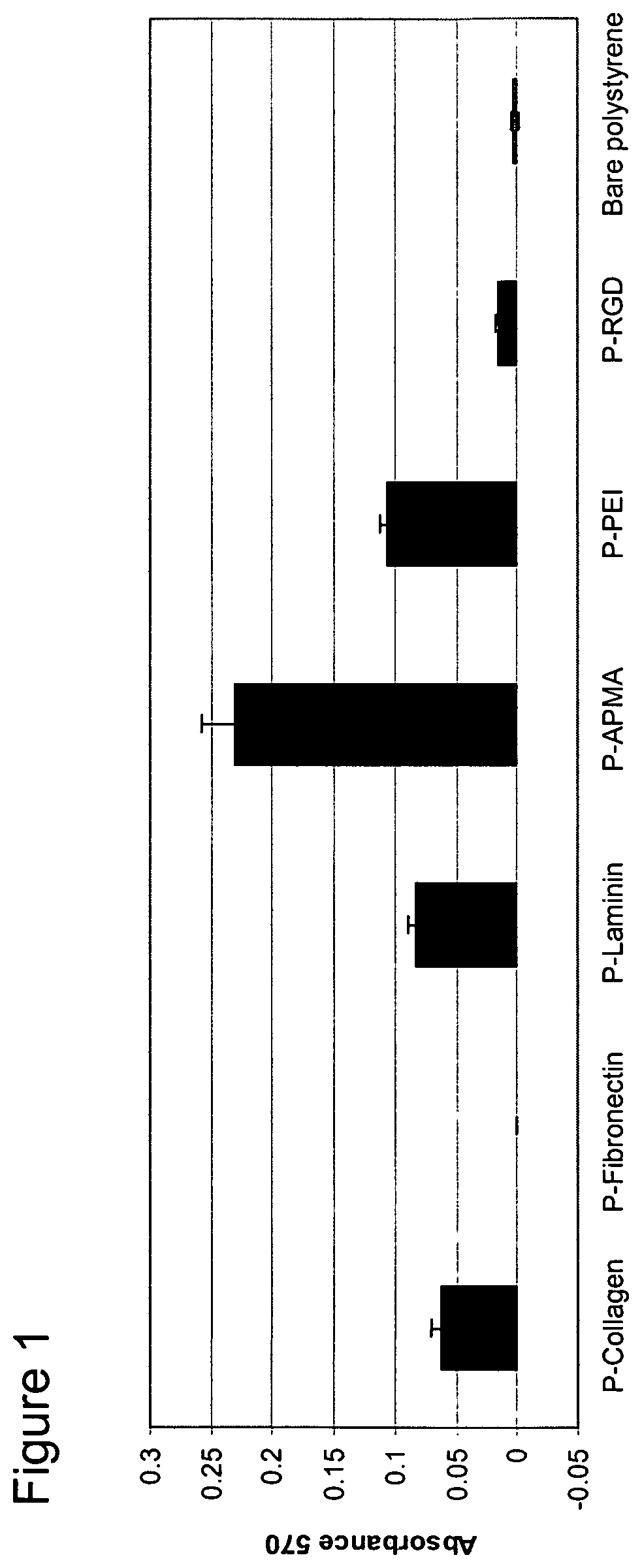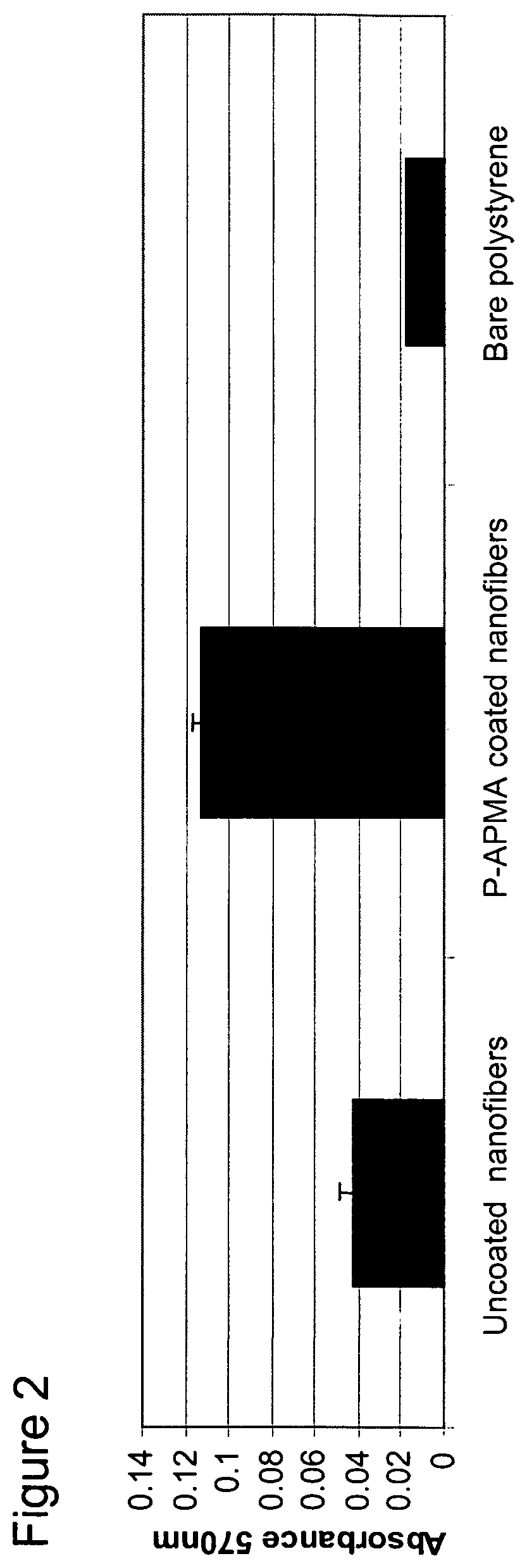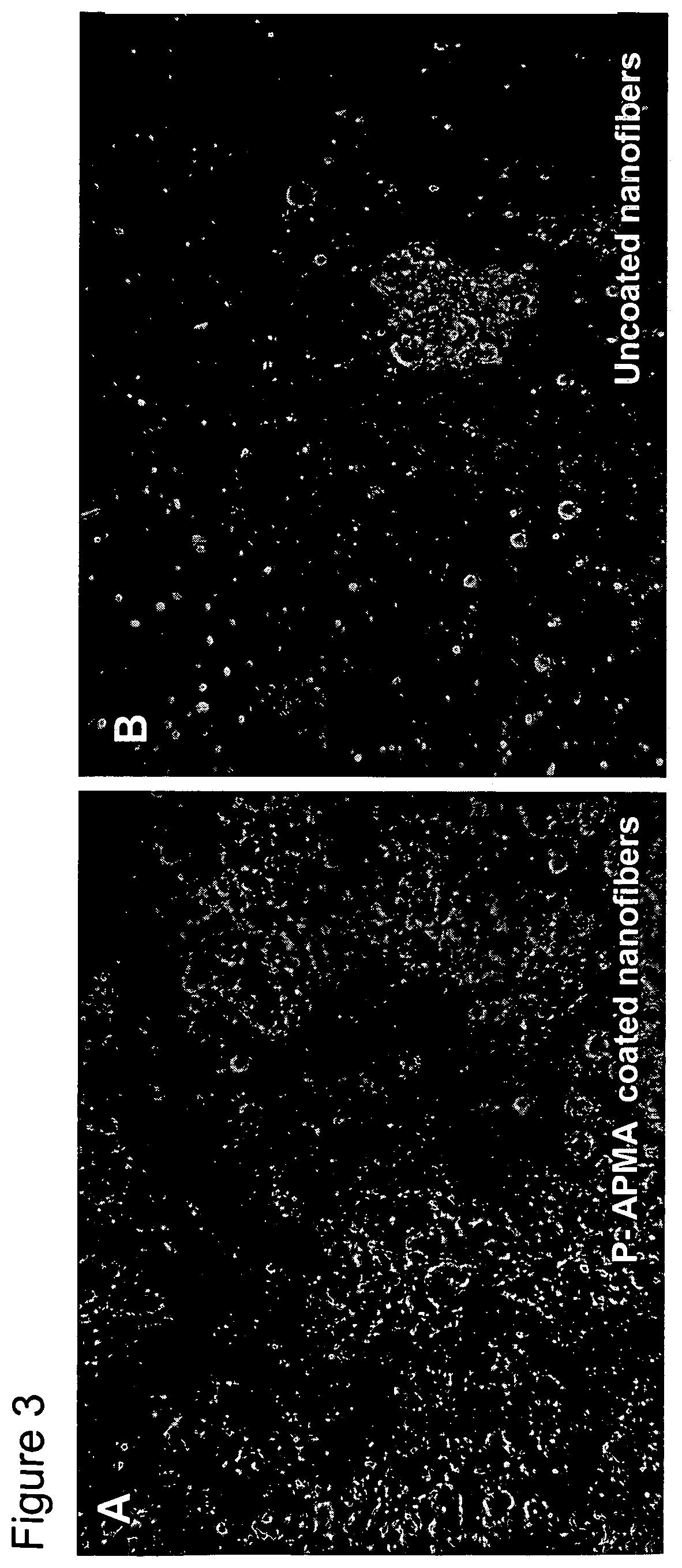Polymeric coatings and methods for cell attachment
a polymer coating and cell technology, applied in the field of coatings, can solve the problems of not all charged surfaces are suitable for the sufficient attachment of cells, negatively charged surfaces do not provide a suitable substrate, and degrade over a period of time, so as to promote cell differentiation, promote neural precursor cell maturation, and promote cell differentiation.
- Summary
- Abstract
- Description
- Claims
- Application Information
AI Technical Summary
Benefits of technology
Problems solved by technology
Method used
Image
Examples
example 1
Photo-Polymeric Reagents
[0119]I. Photo-poly(APMA) The preparation of photo-poly(aminopropylmeth-acrylamide) (photo-poly(APMA) / APO2) was carried out by the copolymerization of N-(3-aminopropyl)methacrylamide hydrochloride (APMA-HCl) and N-[3-(4-Benzoylbenzamido)propyl]methacrylamide (BBA-APMA), the preparation of which are described in Examples 2 and 3, respectively, of commonly assigned U.S. Pat. No. 5,858,653.
[0120]Copolymerization was carried out by adding to a 2 L flask 2.378 g of BBA-APMA (6.7877 mmol), 0.849 of 2,2′-azobis(2-methyl-propionitrile)(AIBN)(5.1748 mmol), and 0.849 g of N,N,N′,N′-tetramethylethylenediamine (TEMED) (6.77 mmol), and then 786 g of dimethylsulfoxide (DMSO) to dissolve the ingredients. The contents were then stirred and deoxygenated with a helium sparge for at least 5 minutes. In a separate flask was dissolved 72.4 g of APMA-HCl (405.215 mmol) in 306 g of DI water with nitrogen sparge. The dissolved APMA-HCl was transferred to the mixture containing BBA-A...
example 2
Substrate Coating
[0129]The photo-polymeric reagents prepared in Example 1 of above were coated onto flat (multi-well plates) and three-dimensional substrates (polymeric nanofibers).
[0130]In order to coat flat surfaces, coating solutions as described in Example 1 in an amount of 1.0 mL were added to wells of 12 well plates (polystyrene; Corning). For substrate coating the depth of the coating solution (the distance from the surface of the solution to the surface of the substrate, either polystyrene or nanofiber) is generally 5 mm or less, and typically in the range of about 1 or 2 mm. A Dymax™ lamp was used to deliver 200-300 mJ of energy as measured using a 335 nm band pass filter with a 10 nm bandwidth (on average, the wells were irradiated for about 3-4 minutes with the lamp held at a distance of 20 cm from the wells). The wells were then washed with buffered saline pH 7.2 to remove any unbound reagents. The wells were then UV illuminated again to sterilize the wells using the sam...
example 3
Attachment Assay of PC12 Cells on Photo-Polymer Coated Substrates
[0134]An attachment assay was performed to determine the effects of plating poorly adherent cells (PC12 cells) on various photopolymer substrates. Rat PC12 (pheochromocytoma) cells obtained from ATCC (accession #CRL 1721) were pre-cultured in collagen-coated polystyrene flasks (15 μg / mL, Sigma) in RPMI medium (Invitrogen) containing 10% horse serum, 5% fetal bovine serum, 2 mM Glutamax (Invitrogen), 1 mM sodium pyruvate (Invitrogen), and 10 mM HEPES (Invitrogen). Cells were incubated at 37° C. in 5% CO2 / 95% air humidified chamber. The media was changed every second day. Cells were trypsinized and passaged when they reached 80% confluency. These culture conditions were followed prior to plating the cells into the 12 well substrates having been coated according to the processes as described in Example 2.
[0135]PC12 cells between passage #2 and passage #10 were used for all experiments performed. The cells were trypsinized...
PUM
| Property | Measurement | Unit |
|---|---|---|
| molecular weight | aaaaa | aaaaa |
| molecular weight | aaaaa | aaaaa |
| time | aaaaa | aaaaa |
Abstract
Description
Claims
Application Information
 Login to View More
Login to View More - R&D
- Intellectual Property
- Life Sciences
- Materials
- Tech Scout
- Unparalleled Data Quality
- Higher Quality Content
- 60% Fewer Hallucinations
Browse by: Latest US Patents, China's latest patents, Technical Efficacy Thesaurus, Application Domain, Technology Topic, Popular Technical Reports.
© 2025 PatSnap. All rights reserved.Legal|Privacy policy|Modern Slavery Act Transparency Statement|Sitemap|About US| Contact US: help@patsnap.com



